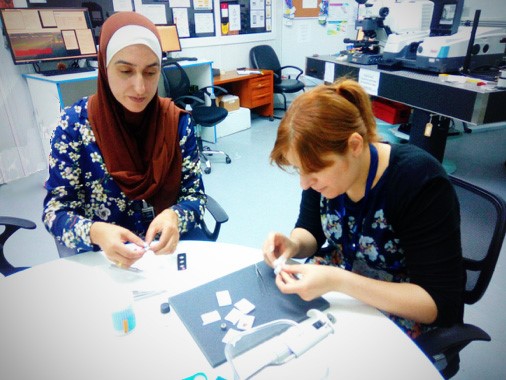The first published paper utilizing data taken at the recently operational IR (Infrared) spectromicroscopy beamline of SESAME describes an interesting possible research path in the identification of the background of preeclampsia, a serious hypertensive disorder with unclear etiology and lack of reliable diagnostic tests. The results of these measurements pave the way to the possibility of early detection of populations at risk.
Released through the Journal of Pharmaceutical and Biomedical Analysis on February 24, 2019, the paper “Investigating the molecular structure of placenta and plasma in pre-eclampsia by infrared microspectroscopy” marked another milestone for SESAME.
In the words of the Principal Investigator, Lina Dahabiyeh from the University of Jordan, Amman, with the results obtained thanks to the experiments carried out on the IR beamline we managed to shed some light on one of the leading causes of maternal and fetal morbidity and mortality worldwide, especially in low- and middle-income countries.
The IR is a completely new beamline, designed and built in collaboration with the French light source, SOLEIL. It allows the application of infrared spectromicroscopy and imaging in a wide range of fields, including surface and materials science (e.g. characterization of new nano-materials for solar cell fabrication and for drug delivery mechanisms), biochemistry, archaeology, geology, cell biology, biomedical diagnostics and environmental science (e.g. air and water pollution). There is a further paper presenting results obtained thanks to experiments on the IR beamline that has been accepted for publication said SESAME’s IR Principal Beamline Scientist, Gihan Kamel, and three more are in their final stage of revision. Moreover, more than 15 papers are currently being prepared.
The first publication of a new beamline, comments SESAME Scientific Director Andrea Lausi, represents a momentous moment for any synchrotron light facility, and even more for SESAME, which is in its teething years of user-dedicated operation. That more than 150 proposals should have been received in the last call demonstrates the constantly growing interest for SESAME’s three beamlines, the MS (Materials Science), IR and XAFS/XRF beamlines, dedicated to powder diffraction, Infrared spectroscopy and X ray absorption/X ray fluorescence respectively.


